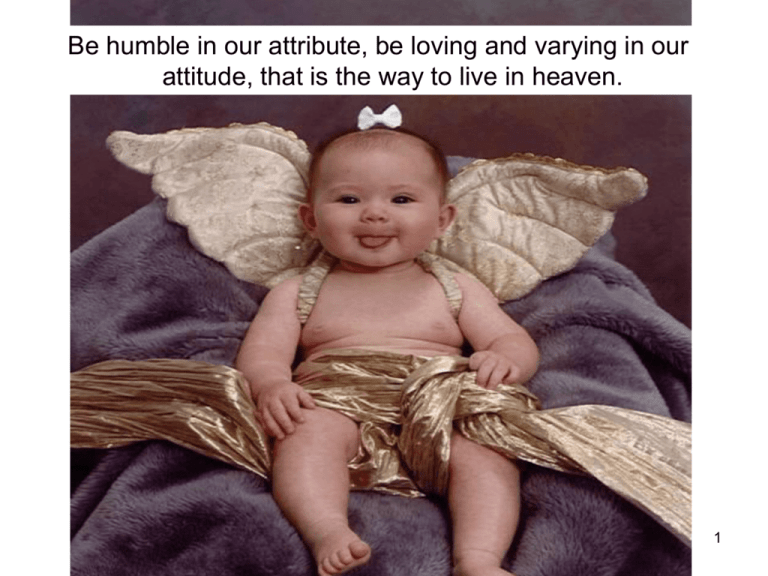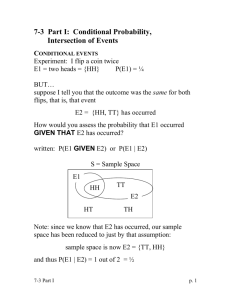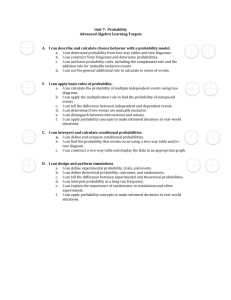Sample space/event
advertisement

Be humble in our attribute, be loving and varying in our attitude, that is the way to live in heaven. 1 Probability Sample space/event Independence Bayes rule 2 This lady has lost 10 games in a row on this slot machine. Would you play this slot machine or another one? 3 Random Circumstance 4 A random circumstance is one in which the outcome is unpredictable. The outcome is unknown until we observe it. Example 1: Traffic Jam on the Golden Bridge 5 < = 20 mph traffic jam How often will a driver encounter traffic jam on the golden bridge during 7-9 am weekdays? __ out of 100 times. Definition of Probability 6 Given a random circumstance, the probability of a specific outcome as the proportion of times it will occur over the long run, i.e. the relative frequency of that particular outcome. Example 2: Coin Flipping 7 What is the probability that a flipped coin shows heads up? Two Ways to Determine Probability 8 Making an assumption about the physical world and use it to find relative frequencies Observing outcomes over the long run Estimating Probability 9 Measuring a representative sample and observing relative frequencies of the sample that fall into various categories Example 3: Employment What is the probability that a CSUEB graduate gets hired in 3 months after graduation? Between 3 to 6 months? More than 6 months? ** Based on a representative sample of 200 graduates, 150, 30, 20 of them got hired in 3, 3-6, and > 6 months, respectively. 10 Probability Definitions Sample space: the collection of all possible outcomes of a random circumstance A simple event is one outcome in the sample space. An event is a collection of one or more simple events (outcomes) in the sample space. ** what are the random circumstances of the examples? ** what are the sample space/simple event/event of the examples? 11 Probability of a Simple Event Between 0 and 1 The sum of the probabilities over all possible simple events is 1 ** examples of probability of an “equally likely” simple event 12 Probability of an Event The sum of the probabilities of simple events in the event ** Revisit the examples and find the events & their probabilities 13 Complementary Events One event is the complement of another event if the two events do not contain any of the same outcomes, and together they cover the entire sample space. ** get hired in 3 months or not ** traffic jam or not ** heads or tails 14 Mutually Exclusive Events Two events are mutually exclusive if they do not contain any of the same outcomes. They are also called disjoint. Q: Are an event and its complement mutually exclusive? ** examples: 15 Independent Events 16 Two events are independent if the probability that one event occurs stays the same, no matter whether or not the other event occurs. Conditional Probability The conditional probability of the event B given the event A, denoted P(B|A), is the long-run relative frequency with which event B occurs when circumstances are such that event A also occurs. ** event A = age 21+; event B = female ** Ask students for age and find P(B|A) 17 Basic Rules for Finding Probabilities P(A or B) = P(A) + P(B) - P(A and B) P(A and B) = P(A)P(B|A) ** P(B|A) = P(A and B)/P(A) ** P(A and B) for disjoint events and for independent events 18 Steps for Finding Probabilities 1. 2. 3. 4. 5. 19 Identify random circumstance Identify the sample space Assign whatever probabilities you know Specify the event for which the probability is wanted Use the probabilities from step 3 and the probability rules to find the probability of interest Tools for Finding Probabilities 20 When conditional or joint probabilities are known for two events Two-way tables For a sequence of events, when conditional probabilities for events based on previous events are known Tree diagrams Strategies for Finding Complicated Probabilities >2 independent events: P(A1 and A2 … and Ak) = P(A1)P(A2)…P(Ak) Bayes Rule: P( A | B) 21 P( A and B) P( B | A) P( A) P( B | A ) P( A ) C C Example: 22 People are classified into 8 types. For instance, Type 1 is “Rationalist” and applies to 15% of men and 8% of women. Type 2 is “Teacher” and applies to 12% of men and 14% of women. Each person fits one and only one type. •What is the probability that a randomly selected male is “Rationalist”? “Teacher”? Both? •What is the probability that a randomly selected female is not a “Teacher”? 23 Suppose college roommates have a particularly hard time getting along with each other if they are both “Rationalists.” A college randomly assigns roommates of the same sex. What proportion of male roommate pairs will have this problem? What proportion of female roommate pairs will have this problem? Assuming that half of college roommate pairs are male and half are female. What proportion of all roommate pairs will have this problem? 24 A psychologist has noticed that “Teachers” and “Rationalists” get along particularly well with each other, and she thinks they tend to marry each other. One of her colleagues disagrees and thinks that the “types” of spouses are independent of each other. • If the “types” are independent, what is the probability that a randomly selected married couple would consist of one “Rationalist” and one “Teacher”? • In surveys of thousands of randomly selected married couples, she has found that about 5% of them have one “Rationalist” and one “Teacher.” Does this contradict her colleague’s theory that the types of spouses are independent of each other? 25








